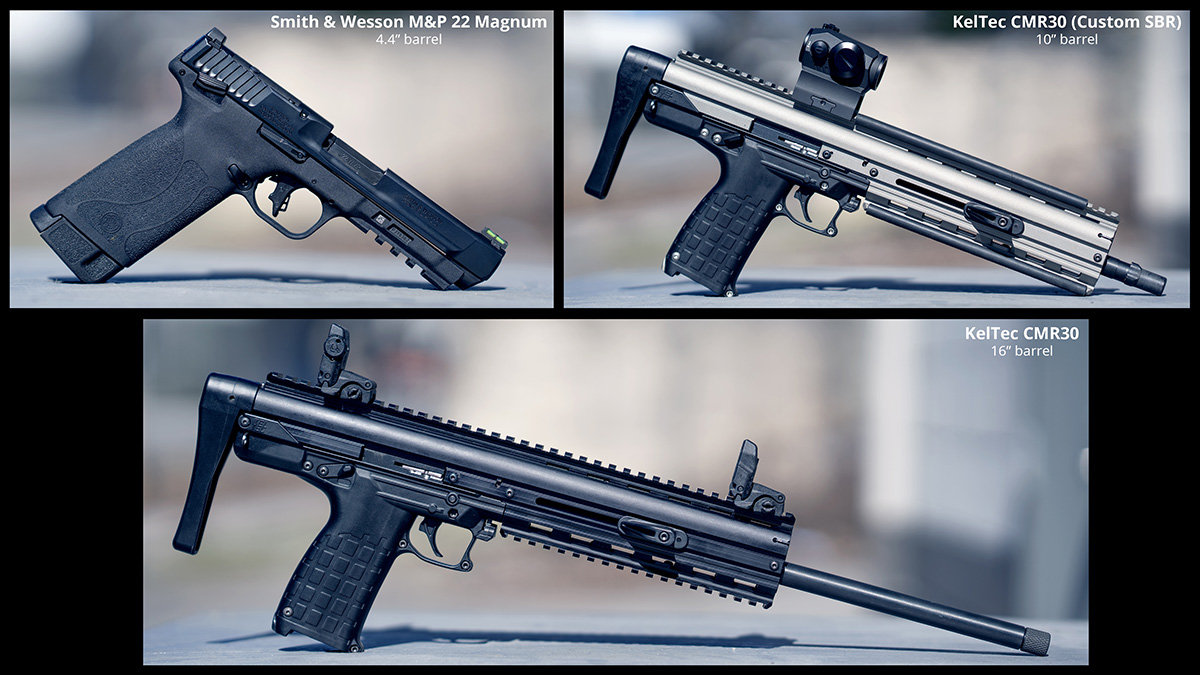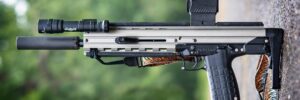It’s the long-awaited conclusion of our two-part series on the 5.7x28mm cartridge (here’s part 1 in case you missed it). This time, we’re looking at more ballistic gel tests and considering when 5.7 might make sense as a self-defense cartridge in the civilian world. Is the hype real, or is it, after all, just the Gucci version of .22 Magnum?
Details are in the video below, or keep scrolling to read the full transcript.
Hey everybody, I am Chris Baker from LuckyGunner.com and this is, finally, part 2 of our series on the 5.7x28mm cartridge.
Last time, we looked at the history of the cartridge and ballistic gel tests of a couple of the most common loads. We also reviewed some feedback from military and law enforcement who have actually used 5.7 in the field. The gel test results did not inspire much confidence, and the end users have not been too impressed either.
But if you take a second look at those accounts, they’re often comparing the performance of 5.7 with the P90 submachine gun to short-barreled 5.56 carbines. 5.7 was originally designed to replace 9mm, not rifle cartridges. Clearly, 5.56 is a better round, ballistically. That doesn’t necessarily mean 5.7 is useless.
So today, we’re going to look at more gel test results to see if some of the newer 5.7 loads can draw better performance out of this cartridge. We’re not expecting rifle-level performance, but we can at least definitively answer the question of whether 5.7 really is just overpriced .22 Magnum.
Just as a reminder, I am deliberately setting aside the armor-piercing potential of 5.7 for this discussion. I realize that is a major appeal of this cartridge for some folks, but for most of us, it’s just not relevant for personal protection. Violent criminals with body armor are an extraordinarily rare threat for the average citizen in the US (at least for now). We have used the FBI 4-layer heavy clothing barrier in all of our gel tests. Otherwise, the gelatin is unarmored.
Four More 5.7 Loads
The gel test results we looked at last time were for two common loads produced by FN. We tested them both with three different test guns. Only one of the tests met the 12-inch minimum penetration standard set by the FBI for service cartridges. And it just barely passed. That was the SS197 V-Max load when fired from the FiveSeven pistol. The rest penetrated around 9 to 10 inches. We’ve seen .22 LR loads that can do better than that, so surely 5.7 has got to be capable of better terminal performance than what we’ve seen so far.
So for today, we have four additional loads. The 40-grain Speer Gold Dot jacketed hollow point – a highly regarded name in self-defense ammo across all calibers, but they just started making a 5.7 load in the last couple of years.
Then we have loads from smaller manufacturers. The Vanguard Outfitters 36-grain GPM. This is a copper bullet that’s designed to open up and fragment. Also from Vanguard is the Black Fang Obsidian Dragon, a 34-grain solid copper bullet. It does not deform or expand, but according to the manufacturer, it “tends to crush bones and disrupt organs.”
And finally, a load that has become almost mythical among 5.7 fans: the Elite Ammunition T6B. This is made in very small batches and is known for being difficult to acquire. It’s another solid copper bullet, and this one has a tip that’s designed to separate from the base on impact.
Gel Test Results
Let’s start with the Gold Dot test results. On the right, we’ve got a photo of the first shot fired from each of our three test guns with the wound channel and temporary cavity highlighted. On the left are the average depth, diameter, and velocity of the five rounds fired from each barrel. Gold Dot performed well out of the FiveSeven pistol with an average depth of 15 inches. Each bullet also expanded consistently to about .31 inches. Unfortunately, with the 10 and 16-inch barrels, we got a repeat of what we saw with the V-Max load in our last video. Too much velocity caused them to expand too quickly, so they did not penetrate past 10 inches.
The Vanguard GPM bullet works more or less as advertised. The four petals opened up and sheared off the bullet, leaving a small core to penetrate. The little pieces lack the energy for any serious wounding potential on their own. The average penetration of the core was around 14 inches for all three barrels, which is not bad. But the core is only about half the mass of the original bullet. So you’re depending on this little 20-grain bullet fragment to incapacitate the target. That’s the equivalent of a single pellet of #4 buckshot.
The marketing copy for the Vanguard Black Fang Obsidian Dragon makes it sound like it creates a temporary cavity with significant wounding potential. For all three barrels, the maximum height of the temp cavity was right around 2.7 inches. That really needs to be closer to about four inches before we can rely on the temp cavity to have any immediate effect on the target. In any case, we do at least get sufficient penetration with this load with all three barrels, and 100% weight retention.
The Elite T6B performed a lot like the Vanguard GPM load. Penetration was between 16 and 18 inches. The tip did break off and separate in all of our tests, leaving the core to penetrate. Like the GPM load, those fragments each weigh about 20 grains. The temp cavities here were somewhat long, but not especially wide or tall.
So, looking at these four loads, plus the two we tested last time, the clear choice for a handgun appears to be the Speer Gold Dot. For the longer barrels, I don’t think there’s a big winner. None of the loads had both penetration and expansion with the 10-inch or 16-inch barrels. That’s not to say there’s no 5.7 load out there that can do it. We just haven’t seen one yet. At the higher velocities, I suspect you would need a heavier bullet to get better penetration when they expand.
Out of these six loads, I’d probably go with the Black Fang since it penetrates with full weight retention. But you don’t need a special boutique load if all you’re looking for is penetration. Plain old 40-grain Federal American Eagle full metal jacket penetrates just fine. It may not punch through body armor, but it penetrates gel. We did not formally test it, so I don’t have any photos for you. We have fired a few rounds in our used gel blocks and it sails through two full 16-inch blocks. It even has a little temporary cavity like most of these other loads.
5.7x28mm versus .22 WMR
That’s not all that surprising. A lot of FMJ ammo performs that way. Like, for instance, .22 Magnum.
So… is 5.7 basically just overpriced .22 Magnum? We looked at the numbers last time, and in terms of velocity and bullet weight, they’re only equal if we compare 5.7 from a pistol to .22 Magnum from a rifle. If we compare rifles to rifles, 5.7 has between 12 and 25% more velocity than .22 Magnum. Comparing pistols to pistols, the velocity gap is roughly double that.
But as we’ve seen, it looks like the designers of 5.7 ammo are having a tough time getting that extra velocity from the longer barrels to do anything productive, except maybe penetrate soft body armor.
If we wanted to know whether 5.7 is truly better than .22 Magnum on an unarmored target, we’d have to also perform gelatin tests with .22 Magnum. And we’d have to do it with three different barrels and at least a handful of different loads. So… that’s what we did.
Our test guns: A Smith & Wesson M&P, a KelTec CMR30 10-inch SBR, and a 16-inch CMR30.
We tested five different loads. We’ve got the CCI 40-grain MaxiMag Total Metal Jacket, then the jacketed hollow point version of that same load, another Speer Gold Dot, a 30-grain V-Max from Hornady, and the Remington 40-grain Jacketed Soft Point. I won’t draw this one out, let’s jump right to the full results.
There’s a lot of shallow penetration here. Some of that is by design. .22 Magnum is often used to hunt small game, and you don’t need deep penetration for that.
Four of the five loads got past the 12-inch mark with the pistol, but only because they did not expand or deform. The Gold Dot expanded but only made it to 11 inches. It got an extra 300 feet per second with the SBR barrel, but penetrated less than 10 inches. The 5.7 Gold Dot at an almost identical velocity got to 15 inches with expansion. That’s a great example of how bullet design matters just as much as mass and velocity.
Like we saw with 5.7, the only .22 mag load that penetrated with the longer barrels was the one that did not expand – the CCI Maxi-Mag Total Metal Jacket.
The Remington Jacketed Soft Point has good-looking numbers here, but that’s only because they’re averages. Looking at the breakdown for each individual shot, you can see that performance was pretty inconsistent with the 10 and 16-inch barrels. Sometimes it expanded and sometimes it didn’t. Penetration was still good across the board with the 10-inch barrel. At 16-inches, we got a couple at the shallow end.
There’s not much of a temporary cavity to speak of with any of the .22 Mag loads. It was slightly bigger with the 5.7s – maybe not big enough to force a change in behavior during a gunfight, but probably enough to make an argument for 5.7 as the superior small game cartridge.
Conclusions from Gel Testing
So the bottom line here: with 5.7 Gold Dot or V-Max out of a pistol, you can get performance similar to a non-expanding 9mm or .380 ACP. Otherwise, for any combination of barrel length and any one of these eleven loads, you have to pick either penetration or expansion. .22 Magnum can poke a .22 caliber hole with good penetration. 5.7 will do the same thing, but maybe with a temp cavity that looks good on camera.
5.7 for the Armed Citizen
Now, I don’t say any of that to dismiss either of these cartridges. They may not have the best ballistics. But as gun people, we often mistake non-optimal for unacceptable. That’s not always a helpful way to look at it. It’s okay to settle for “non-optimal” if we’re getting something in return.
In the case of both 5.7 and .22 Magnum, the upside of mediocre ballistics is exceptionally low recoil. Low recoil leads to better shot placement. And as long as the bullet can penetrate, shot placement usually trumps ballistics.
Of course, the low recoil advantage goes a much longer way for novice shooters than for the highly skilled, but it always helps at least a little. And with a carbine, 9mm and 5.56 are already pretty easy to handle recoil-wise, even for a new shooter, so it’s more of an advantage for handguns. But it’s an advantage you can get from either .22 Magnum or 5.7×28.
Practically speaking, the major advantage of .22 Magnum is the cost of ammo, which is typically on par with 9mm. The cost of 5.7 has dropped in recent years, but it’s still about twice as much as nine. The other benefit of .22 Mag is that you can get it in a super lightweight snub nose revolver like the 11 ounce Smith & Wesson 351C. So far, the smallest gun you can get chambered for 5.7 is a full size semi-auto.
On the other hand, 5.7 is a centerfire round and therefore more reliable than a rimfire cartridge. Stacking rimmed cartridges in a magazine is always a sketchy proposition. For a semi-automatic self-defense gun, I’d much rather rely on a 5.7 to function reliably. Reliability should be a top priority for any life-saving tool. So for that very important reason, 5.7 is more than just overpriced .22 Magnum. But I’m still going to laugh every time I see this classic meme.
Okay guys, that’s all I’ve got on 5.7 for now (and probably for a long while, to be honest). Hope you enjoyed it. And the next time you need some ammo, be sure to get it from us with lightning fast shipping at LuckyGunner.com.


















